INDIAN ARMED FORCES CHIEFS ON OUR RELENTLESS AND FOCUSED PUBLISHING EFFORTS

The insightful articles, inspiring narrations and analytical perspectives presented by the Editorial Team, establish an alluring connect with the reader. My compliments and best wishes to SP Guide Publications.

"Over the past 60 years, the growth of SP Guide Publications has mirrored the rising stature of Indian Navy. Its well-researched and informative magazines on Defence and Aerospace sector have served to shape an educated opinion of our military personnel, policy makers and the public alike. I wish SP's Publication team continued success, fair winds and following seas in all future endeavour!"

Since, its inception in 1964, SP Guide Publications has consistently demonstrated commitment to high-quality journalism in the aerospace and defence sectors, earning a well-deserved reputation as Asia's largest media house in this domain. I wish SP Guide Publications continued success in its pursuit of excellence.
- Indian Air Force Aims for Full Indigenous Inventory by 2047 — Air Chief Marshal A.P. Singh
- Rajnath Singh assumes charge as Defence Minister for the second consecutive term
- Interim Defence Budget 2024-25 — An Analysis
- Union Defence budget 2024
- Prime Minister Modi Flies in the LCA Tejas
- New Chapter in India-Italy Defence Ties
- Airpower beyond Boundaries
Union Defence budget 2024
A continuous push by the Government for military indigenisation amid fiscal prudence
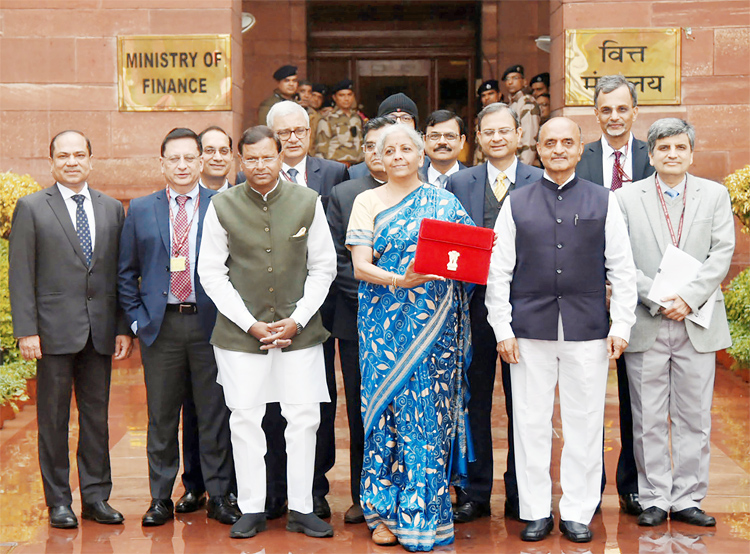
In the Interim Union Budget for fiscal 2024-25, the government has maintained the continued thrust on building self-reliance towards military modernisation and fiscal prudence amid rising geopolitical conflicts and regional threats. The government has allocated 6,21,540.85 (6.21 lakh) crore for the defence budget in the Financial Year 2024-25. This comes out to be 13.04 per cent of the total Union Budget, which Finance Minister Nirmala Sitharaman presented in Parliament on February 1, 2024.
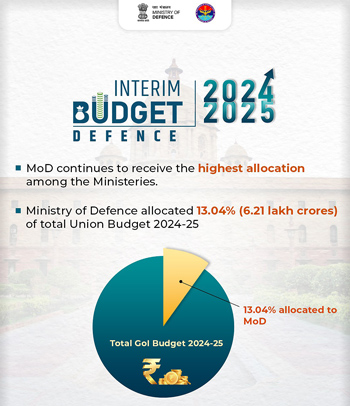

Within the constraint of an Interim Budget, the government managed a modest hike, by pushing the defence budget to 6.21 lakh crore for 2024-25 from last year's allocation of 5.94 lakh crore. The biggest takeaway from the Interim budget is the overarching focus on new and emerging technologies which aimed to address the elements of the shifting nature of warfare. The finance minister announced an ambitious scheme for "deep-tech" technologies in the military domain. A special allocation of 1 lakh crore corpus for Deep Tech for the start-ups includes the defence sector under the national mission.
The government allocated 6.21 lakh crore for the defence budget in the Financial Year 2024-25, representing 13.04 per cent of the total Union Budget.
According to the data from the government, the Ministry of Defence (MoD) has received the highest allocation among the ministries. The budgetary allocation to Defence for FY 24-25 is higher by one lakh crore (18.35 per cent) than the allocation for FY 2022-23. Overall, the hike of 4.72 per cent is mandated for the year then FY 23-24.
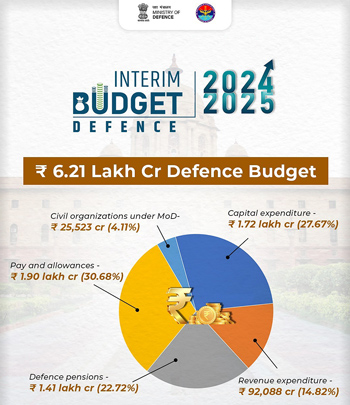
However, the capital allocation gets the major share of 27.67 per cent which is marked for the crucial modernisation of the armed forces. Thus, the capital expenditure in Defence for FY 24-25 is 1.72 lakh crore which is 20.33 per cent higher than the actual expenditure of FY 22-23 and 9.40 per cent more than the Revised Allocation of FY 23-24.
Additionally, besides the major chunk of the capital allocation in the defence budget, the government allocates 14.82 per cent for revenue expenditure on sustenance and operational preparedness, 30.68 per cent for Pay and allowances, 22.72 per cent for defence pensions and 4.11 per cent for civil organisations under the MoD.
Capital expenditure receives a major share, aimed at modernising the armed forces, with 1.72 lakh crore allocated for FY 24-25, a 20.33 per cent increase over the actual expenditure of FY 22-23.
Total Budgetary allocation on account of Defence pensions is 1.41 lakh crore which is 2.17 per cent higher than the allocation made during 2023-24.
The key feature of the budgetary allocation also mandates the better utilisation of the capital budget for three services through the combined assessment and expenditure of such items as Land, Aircraft and Aero Engines, Heavy and Medium Vehicles etc.
Budget 2024: Long-Term Integrated Perspective Plan (LTIPP)
The focus on Defence Capital Expenditure builds up on the inherent challenges towards the capability roadmap for the armed forces amid current geopolitical conflicts and threats around. Addressing the critical need for aircraft and aero engines, 40,777 crore is marked amid the ongoing indigenous efforts for upcoming mega projects like Advanced Medium Combat Aircraft (AMCA) and Tejas 2. Additionally, 62,343 crore has been allocated for "other equipment". The defence budget also provides provisions for additional funds for the LCA MK–II (OC configuration) under the existing order for the IAF.
The budget emphasises investment in new and emerging technologies for military modernisation, including a special allocation of 1 lakh crore for "deep-tech" technologies in the defence sector.
According to the official from the MoD, the budget continues to address the requirement for niche and advanced technology and weapons, fighter aircraft, ships, and military platforms. On the Perspective plan, the MoD has earmarked a capital budget for unmanned aerial vehicles, drones, specialist vehicles etc.
The capital budgetary allocation includes the modernisation of the existing Su-30 fleet and additional procurement of aircraft. This takes account of the planned acquisition of advanced engines for existing MiG-29, and acquisition of transport aircraft C295 and missile systems.
Significant allocations are made for key defence projects, such as aircraft and aero engines, naval fleet modernisation, border infrastructure development, and the Defence Research and Development Organisation (DRDO), indicating a focus on capability development and strategic needs.
Another key area that the government has taken into account is the acquisition of Deck-based fighter aircraft, Submarines, next-generation survey vessels and minesweepers for the Indian Navy. Overall, an outlay of 23,800 crore has been made for the naval fleet and 6,830 crore for the various ongoing projects of the naval dockyard. According to a senior MoD official, this will add to the ship-building sector with a planned investmentof 1.5 lakh crore in naval ship-building projects, aggregating the overall estimates of about 2.73 lakh crore.
Revenue Expenditure
In the interim budget, the allocation for the revenue expenditure (Other than Salary) meant for sustenance and operational commitment for FY 24-25 remains at 92,088 crore. As per the data, it is 48 per cent higher than the budgetary allocation of FY 2022-23. The revenue allocation primarily includes upgrading maintenance facilities and support systems to all platforms, including aircraft and ships. Besides, it also includes the procuring of ammunition, logistics, and movement of personnel for day-to-day expenditure of the Armed Forces.
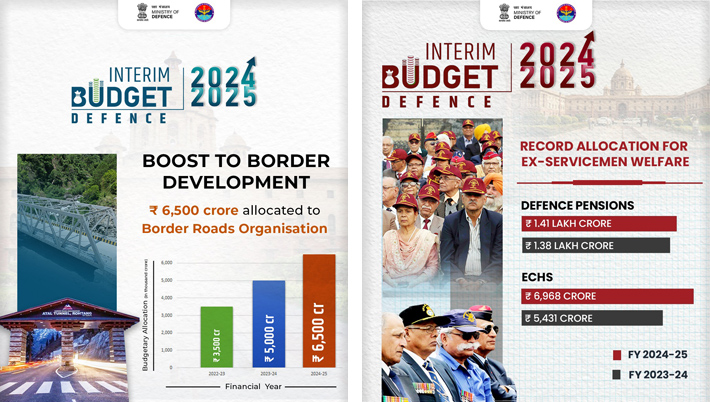
In the interim budget, the government has continued its push for infrastructure, construction, manufacturing, and housing towards the need to improve Border Infrastructure for strategic requirements. Some of the strategic allocations are specially assigned for the projects such as the development of Nyoma Airfield in Ladakh at an altitude of 13,700 feet. Other major border infrastructure projects include the bridge connectivity in Andaman and Nicobar Island, the 4.1 km strategically important Shinku La tunnel in Himachal Pradesh and Nechiphu tunnel in Arunachal Pradesh among others.
Defence R&D
In the overall scheme of capability development and thrust on modernisation, the government has allocated 23,855 crore to the Defence Research and Development Organisation (DRDO). However, there is only a marginal increase in FY 2024-25 from 23,263.89 crore in FY 2023-24. Of this allocation, a major share of 13,208 crore is allocated for capital expenditure.
It aims to spur the policy thrust on building military-industrial ecosystem based on collaboration with public and private defence entities through the development-cum-production partner.
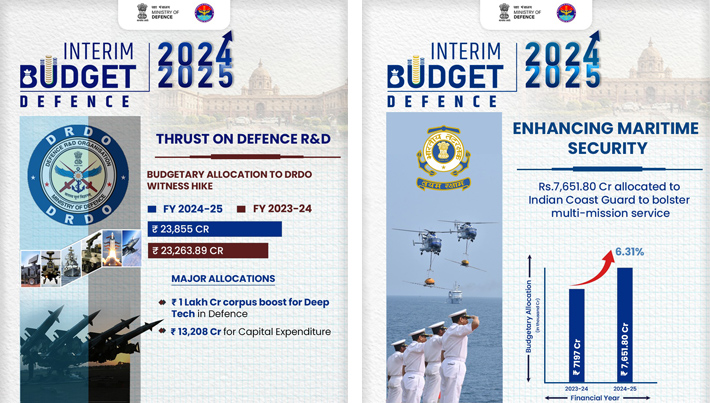
The budget also continues to build on the defence startups by allocating 60 crore to the Technology Development Fund (TDF) scheme for new start-ups, MSMEs and academia.
For the Indian Coast Guard, the government allocates 7,651.80 crore. There is a modest increase of 6.31 per cent higher than the allocation for FY 2023-24. Of this, 3,500 crore is to be incurred only on capital expenditure, to address the emerging challenges posed by water and provide humanitarian assistance to other nations. The allocation includes the acquisition of fast-moving patrolling vehicles, interceptors, advanced electronic surveillance systems and weapons.
Manish Kumar Jha is a Consulting & Contributing Editor for SP's Aviation, SP's Land Forces and SP's Naval Forces and a security expert. He writes on national security, military technology, strategic affairs & policies.





